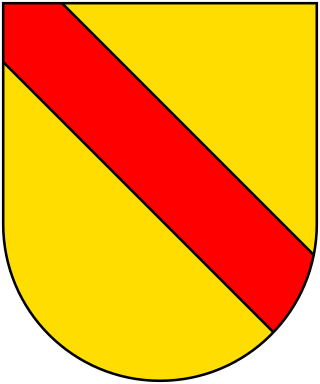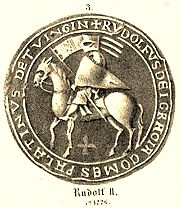Herman IX, Margrave of Baden-Eberstein (died 13 April 1353) was a titular Margrave of Baden and a ruling Lord of Eberstein.
He was the son of Margrave Frederick II and his first wife Agnes of Weinsberg (d. 3 May 1320). When his father died in 1333, he succeeded him as Margrave of Baden-Eberstein.
In 1344, he delivered Yburg Castle to Margrave Rudolf IV (d. 1348). In 1350, after Rudolf IV's death, Emperor Charles IV enfeoffed Yburg Castle again to Herman IX. In the same year, he purchased the village of Mörsch from Herrenalb Abbey. Rudolph IV had sold the village to the abbey, with an option to buy it back.
On or before 3 June 1341, he married Mathilda of Vaihingen (d. 13 April 1381). They had one son, Frederick IV.
Herman IX died in 1353. As Frederick IV had died before him, Eberstein fell to his first cousin once removed Rudolf VI of the main Baden-Baden line.

The House of Zähringen was a dynasty of Swabian nobility. The family's name derived from Zähringen Castle near Freiburg im Breisgau. The Zähringer in the 12th century used the title of Duke of Zähringen, in compensation for having conceded the title of Duke of Swabia to the Staufer in 1098. The Zähringer were granted the special title of Rector of Burgundy in 1127, and they continued to use both titles until the extinction of the ducal line in 1218.
Berthold II, Duke of Carinthia, also known as Berthold I of Zähringen, was a progenitor of the Swabian House of Zähringen. From 1061 until 1077, he was the Duke of Carinthia and Margrave of Verona.

The Margraviate of Baden was a historical territory of the Holy Roman Empire. Spread along the right banks of the Upper Rhine in south-western Germany, it was named a margraviate in 1112 and existed until 1535, when it was split into the two margraviates of Baden-Durlach and Baden-Baden. The two parts were reunited in 1771 under Margrave Charles Frederick, even if the three parts of the state maintained their distinct seats to the Reichstag. The restored Margraviate of Baden was elevated to the status of electorate in 1803. In 1806, the Electorate of Baden, receiving territorial additions, became the Grand Duchy of Baden. The rulers of Baden, known as the House of Baden, were a cadet line of the Swabian House of Zähringen.
Herman I of Baden was the titular Margrave of Verona and the ancestor of the line of Margraves of Baden.

Rudolf VI of Baden was Margrave of Baden-Baden and Count of Eberstein from 1353 to 1372.

Herman V, Margrave of Baden ruled Verona and Baden from 1190 until his death.

Rudolf I, Margrave of Baden served as Regent to Margrave Frederick I from 1250 until 1267, then as Margrave of Baden from 1268 until his death in 1288.

Edward Fortunatus of Baden was Margrave of Baden-Rodemachern and Baden-Baden.
Bad Rotenfels is a district in the city of Gaggenau, district of Rastatt, in Baden-Württemberg, Germany. It is located some 8 km northeast of Baden-Baden.

Rudolf Hesso of Baden-Baden was a son of Hesso, Margrave of Baden-Baden and his wife, Adelaide of Rieneck. He succeeded his father as Margrave of Baden-Baden in 1297, and ruled jointly with his uncle, Rudolf III. From 1332 to 1335, he ruled alone.

Rudolf IV, Margrave of Baden-Pforzheim was a son of Margrave Herman VII of Baden and his wife, Agnes of Truhendingen.
Hesso, Margrave of Baden-Baden was a son of Rudolf I and his wife, Kunigunde of Eberstein. After his father died in 1288, he ruled the Margraviate of Baden jointly with his brothers Rudolf II, Herman VII and Rudolf III.

Herman VII, Margrave of Baden-Baden, nicknamed the Rouser, , was the ruling Margrave of Baden from 1288 until his death.
Countess Palatine Irmengard of the Rhine, also known as Irmengard of Baden was Margravine of Baden by her marriage to Herman V, Margrave of Baden-Baden. She brought the city of Pforzheim into the marriage.

Frederick II, Margrave of Baden was the ruling Margrave of Baden-Eberstein from 1291 until his death. He was the son of Herman VII of Baden and Agnes of Trunhendingen.

Henry II, Margrave of Baden-Hachberg was the ruling Margrave of Baden-Hachberg from 1231 to 1289.

Rudolph II, Count Palatine of Tübingen was Count Palatine of Tübingen and Vogt of Sindelfingen. He was the younger son of Rudolph I and his wife Matilda of Gleiberg, heiress of Giessen.

The Yburg is a ruined hilltop castle atop the Yberg, on the western edge of the Black Forest near Baden-Baden, in southwestern Germany.

Henry I, German: Heinrich I from the House of Zähringen was margrave of Baden-Hachberg. He was the founder of the Baden-Hachenberg branch.
This page is based on this
Wikipedia article Text is available under the
CC BY-SA 4.0 license; additional terms may apply.
Images, videos and audio are available under their respective licenses.













